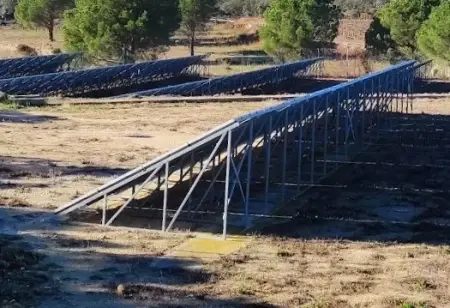
Solar panel frames are systems specifically designed to hold photovoltaic modules in place and provide the optimal tilt to capture the maximum amount of solar energy.
Their importance lies in the fact that they guarantee not only the correct fastening of the panels, but also their proper orientation to make the most of the available solar radiation.
Selecting the right structure
When it comes to choosing the right structure for photovoltaic panels, several factors must be carefully considered.
- The surface where the panels will be installed
- The desired orientation
- Geographic location are critical aspects to take into account.
There are different types of structures to adapt to various surfaces, such as metal roofs, tile roofs, elevated or ground installations, and even wall-mounted structures. Each of these options offers specific advantages depending on the needs of the project.
Let's look in more detail at some of the types of structures mentioned:
Metal roof structures
These structures are specifically designed to be installed on roofs with metal covers. They are characterized by their ability to adapt to the inclination of the existing roof, making installation easier and ensuring a secure fit. The inclination of the panels follows the slope of the roof, maximizing solar exposure and energy efficiency.
Structures for tile roof
For those who have tiled roofs. They allow the solar panels to be fixed directly on the tiles without the need to drill them, which guarantees a safe installation without damage to the roof.
elevated structures
These structures raise the solar panels to a certain height above the ground, which allows better ventilation and prevents the accumulation of dirt under the panels.
They are ideal for installations on uneven terrain or for those who want to take advantage of the space available under the panels for other purposes, such as parking or storage. They are also used to avoid shaded areas near the ground.
Floor structures
Floor structures are versatile and can be installed on both flat terrain and flat roofs. They offer different inclination angles to adapt to the needs of each project and are usually the preferred option for large commercial or industrial solar installations.
Wall structures
These designs are ideal for installing photovoltaic panels on vertical surfaces, such as building walls or fences. They allow proper orientation of the panels to maximize solar energy collection, even in spaces with horizontal space limitations.
Types of structures for photovoltaic panels
Solar panel structures are classified into several categories based on their design and location. Below we offer a brief description of different types of structures:
Estructuras Tipo "B" y "H"
These structures are characterized by their arrangement in vertical columns. The solar panels are mounted on the columns, allowing them to be suspended in the air.
This design provides exceptional stability and is ideal for spaces where uniform panel distribution is required, such as in open fields or unobstructed areas of terrain.
Structures Type "V"
"V" type structures are designed specifically for flat surfaces, such as land or terraces.
These structures allow easy and efficient installation of photovoltaic modules on the ground, providing an optimal inclination to maximize solar energy collection. Their versatile design makes them ideal for residential, commercial and industrial applications.
Structures Type "A"
This type of structure is especially suitable for solar panels with specific powers, generally in the range of 280 to 325 watts.
Designed for ground installations, these structures offer a stable and safe platform for the panels, ensuring optimal performance and long life.
Structures Type "S"
"S" type structures are characterized by their design that allows the solar modules to rest directly on the structure. This type of installation offers a specific orientation of the panels with respect to the ground, which allows efficient collection of solar energy.
They are ideal for applications on vertical surfaces, such as walls or fences.
The importance of inclination
The tilt of photoelectric panels plays a crucial role in their performance because it determines the amount of sunlight they can capture. An optimal inclination maximizes sun exposure, increasing the efficiency in converting solar radiation into electricity and minimizing the impact of shading.
Although some structures offer a fixed inclination based on the latitude of the location, others allow adjustments to optimize the collection of solar radiation. Calculating the proper inclination is essential to maximize the efficiency of the installation.
Construction materials
Materials used in solar panel structures, such as aluminum, galvanized steel, and stainless steel, must be durable and resistant to adverse weather conditions.
Aluminum is widely used in the manufacture of structures for solar panels due to its lightness and resistance to corrosion. This material does not rust easily, ensuring long life even in humid or saline environments. Additionally, its light weight facilitates installation and reduces structural loading on the roof or surface where the panels are mounted.
Galvanized steel consists of steel coated with a layer of zinc to protect it from corrosion. The structures made of galvanized steel are robust and weather resistant.
Lastly, stainless steel also offers exceptional corrosion resistance and high durability. This material is a popular choice for applications where superior protection against rust and deterioration is required. Structures made of stainless steel are ideal for regions with extreme climates or exposure to aggressive environments.